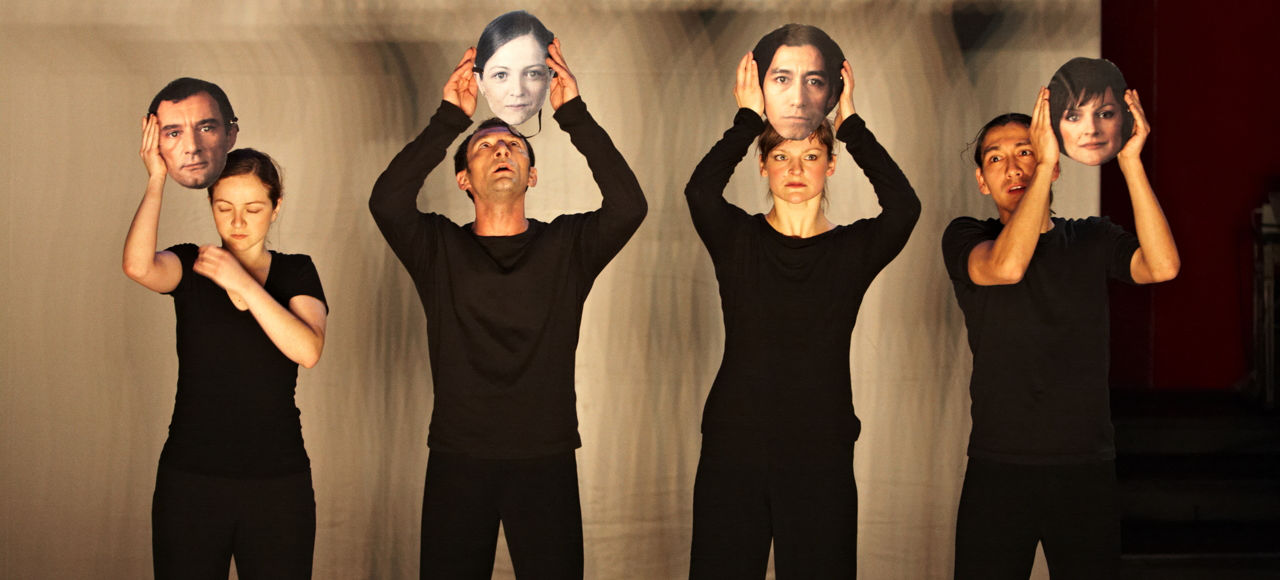
I is another
It is wrong to say: I think. One ought to say: I am thought.
I is another. Too bad for the wood that finds it is a violin, and you can scoff at fools who quibble over things they know nothing about!
Rimbaud (from a letter to Georges Izambard, 1871)
Cast
Ensemble of the world premiere on January 9, 2008 in the FFT-Juta Düsseldorf
Choreography: Jacqueline Fischer
Production Management, Soundsupervising, Video: J.U.Lensing
Actors:
Catalina Gomez, Francesco Pedone, Hana Zanin, Jose Fernando Andrade-Lopez
Moderator: J.U.Lensing
Music: Michael Sapp
Musicians:
Michael Sapp: accordion, harmonium; Electric guitar, Ezraj
Bassem Hawar: Djoze, violin
Donja Djember: Violoncello
Costumes: Margit Koch
Stage design: Simona Lotti
Light: Jeannot Bessiere
Production Assistance: Miriam Raether
Photos: Oliver Eltinger
Print design: Ernst Merheim
About the Production
I is another (Arthur Rimbaud)
Modern literature was quick to recognize the difficulty – the impossibility even – of constructing a narrative with the “I” or the “ego” as its unifying element, whether this was the author’s own “ego” or that of a fictional character.
Starting from a famous quote from the poet Arthur Rimbaud, – “I is another” – the actors explore and comment on a series of different types and prototypes-, returning again and again to the question of what constitutes personal identity and actively encouraging the audience to reflect on this question from different angles.
The “play” is not so much about the way professional actors recreate a person’s existential environment (what Bordieu calls the “habitus”) through posture, voice and gestures but rather about how people and bodies are re-modelled to reflect the multitude of types available to us in modern society.
Are social classes, status, wealth, poverty, power, helplessness genetically “determined” – or are they the result of ego- modelling? What defines the individual and how? What factors can suddenly change a previously conventional life? What is meant by character, ethos or point of view in a world of stage-managed “I’s”?
“I is another” mirrors on the physical as well as the verbal level (reflected through the words of the text) what is happening everywhere today as people invest in self representation and social role-playing!
I is another: Press
Beautiful Dance around Me
By all means of multimedia art and specially made masks, the ensemble tries, in addition to José Fernando Andrade-Lopez include Catalina Gomez, Francesco Pedone and Hana Zanin to explore the question of the character of a person. Full of desire, the quartet storms through his scenes with music, works with bands that are typical of rhythmic gymnastics, and that have a flickering point of light at the end, and provides entertainment with the change between light and shadow.
An important function is mirrored speakers, through which the quartet moves well or which can be optimally used to hide itself or a self that is just not acceptable. Jacqueline Fischer’s interpretation of the civilizational abysses, ego and superego or the so-called soft skills, is a lively game whose individual ideas are not always new, but consistently entertained.
Westdeutsche Zeitung
Plays behind Mirrors
A heavy theme, feather-light staged by choreographer Jacqueline Fischer. Four figures in black whirr through a gloomy room. Sometimes with candles or lights they go in search. Mostly, however, they wear masks or mirrors in front of their faces. Two men and two women – decorated with paper pictures of their own portraits, then the other dancers’ faces are glued to their noses again. And so suddenly a woman becomes an Er, a man becomes one, and vice versa. Gradually, the observer understands that this is not just about transformation, the primal theme of the theater, but also about the original question of man: who am I?
He, she, it – or even “I am someone else”: Based on this quote from a poem by Arthur Rimbaud, the “Theater of Sounds” develops an enigmatic dance evening that blows swiftly and lightly over the boards. If the title of the play – and the program booklet – also convey thoughtfulness, then Jacqueline Fischer manages to bring light-footed impressions across the ramp. The choreography sparkles with wit, temperament and light irony, yet raises existential questions.
Apart are the sequences in which digital phantom images, which the police use to hunt down criminals, slowly change, blur into each other. The portrayals of the performers show how the computer world influences our perception – the old becomes young, the man becomes the woman, the benevolent beam sneaky grin. A new identity with a mouse click.
Neue Rhein Zeitung
Lightening the “I”
The mirror as the most important element to be able to look at its own surface, plays a major role in the course of the play. The dancers are constantly standing in front of them, looking at each other, styling themselves, trying to recognize their self. Be it the large mirror installations or with the help of smaller mirrors, with which they thoroughly examine every single part of the body. With flashlights they try to bring light into the darkness of their own personality. Meticulously they try to shed light, always in search of an inner core. Even photomasks of their own faces are used repeatedly.
This makes it possible to play a wonderfully confusing game: reversed, the faces alienate the bodies to which they actually do not belong. Women’s bodies dance with male faces. Men’s bodies move more feminine with women’s faces. A third element is a little baby doll. Bitterly, as Catalina Gomez tries to teach the little doll to walk, and in between, thinks about small nasties, drops them or throws them too high, so that they bounce hard. Gomez laughs maliciously.
Atmospherically, the excellent live musicians (Bassem Hawar, Donja Djember, Michael Sapp) support these pictures. With their wonderful instruments (including violin, cello, accordion, harmonium) they move musically between tango and abstract spherical sounds.
Overall, the ensemble finds a large variety of images.
Rheinische Post